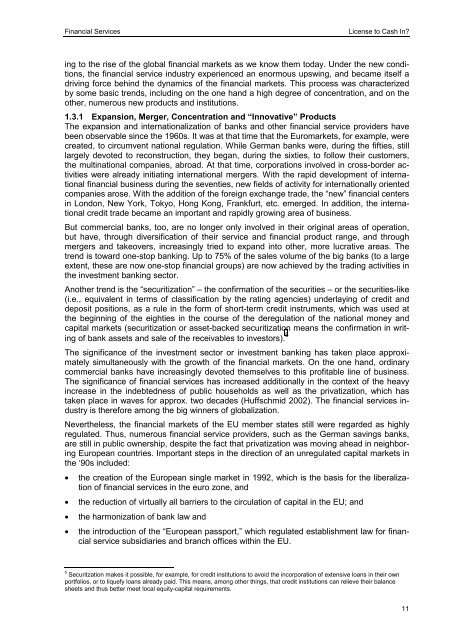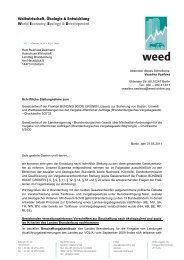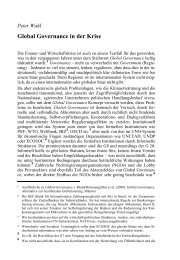LICENSE TO CASH IN? - Weed
LICENSE TO CASH IN? - Weed
LICENSE TO CASH IN? - Weed
- No tags were found...
Create successful ePaper yourself
Turn your PDF publications into a flip-book with our unique Google optimized e-Paper software.
Financial ServicesLicense to Cash In?ing to the rise of the global financial markets as we know them today. Under the new conditions,the financial service industry experienced an enormous upswing, and became itself adriving force behind the dynamics of the financial markets. This process was characterizedby some basic trends, including on the one hand a high degree of concentration, and on theother, numerous new products and institutions.1.3.1 Expansion, Merger, Concentration and “Innovative” ProductsThe expansion and internationalization of banks and other financial service providers havebeen observable since the 1960s. It was at that time that the Euromarkets, for example, werecreated, to circumvent national regulation. While German banks were, during the fifties, stilllargely devoted to reconstruction, they began, during the sixties, to follow their customers,the multinational companies, abroad. At that time, corporations involved in cross-border activitieswere already initiating international mergers. With the rapid development of internationalfinancial business during the seventies, new fields of activity for internationally orientedcompanies arose. With the addition of the foreign exchange trade, the “new” financial centersin London, New York, Tokyo, Hong Kong, Frankfurt, etc. emerged. In addition, the internationalcredit trade became an important and rapidly growing area of business.But commercial banks, too, are no longer only involved in their original areas of operation,but have, through diversification of their service and financial product range, and throughmergers and takeovers, increasingly tried to expand into other, more lucrative areas. Thetrend is toward one-stop banking. Up to 75% of the sales volume of the big banks (to a largeextent, these are now one-stop financial groups) are now achieved by the trading activities inthe investment banking sector.Another trend is the “securitization” – the confirmation of the securities – or the securities-like(i.e., equivalent in terms of classification by the rating agencies) underlaying of credit anddeposit positions, as a rule in the form of short-term credit instruments, which was used atthe beginning of the eighties in the course of the deregulation of the national money andcapital markets (securitization or asset-backed securitization means the confirmation in writingof bank assets and sale of the receivables to investors). 5The significance of the investment sector or investment banking has taken place approximatelysimultaneously with the growth of the financial markets. On the one hand, ordinarycommercial banks have increasingly devoted themselves to this profitable line of business.The significance of financial services has increased additionally in the context of the heavyincrease in the indebtedness of public households as well as the privatization, which hastaken place in waves for approx. two decades (Huffschmid 2002). The financial services industryis therefore among the big winners of globalization.Nevertheless, the financial markets of the EU member states still were regarded as highlyregulated. Thus, numerous financial service providers, such as the German savings banks,are still in public ownership, despite the fact that privatization was moving ahead in neighboringEuropean countries. Important steps in the direction of an unregulated capital markets inthe ‘90s included:• the creation of the European single market in 1992, which is the basis for the liberalizationof financial services in the euro zone, and• the reduction of virtually all barriers to the circulation of capital in the EU; and• the harmonization of bank law and• the introduction of the “European passport,” which regulated establishment law for financialservice subsidiaries and branch offices within the EU.5 Securitzation makes it possible, for example, for credit institutions to avoid the incorporation of extensive loans in their ownportfolios, or to liquefy loans already paid. This means, among other things, that credit institutions can relieve their balancesheets and thus better meet local equity-capital requirements.11
















